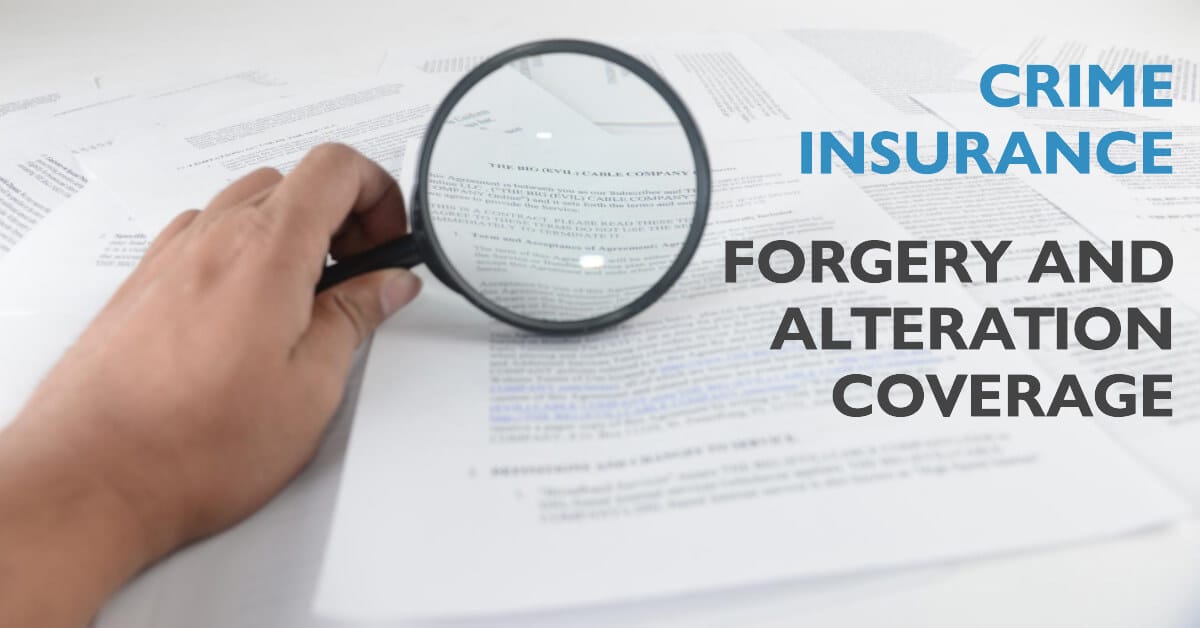Today, we’re going to talk about something important for business owners like yourself: crime insurance and, specifically, forgery and alteration coverage.
Companies rely on a multitude of valuable documents, including checks, contracts, and critical papers, which serve as the backbone of their operational integrity. Unfortunately,if an employee or an individual seeks to deceive and manipulate by altering or forging these crucial documents it would break the backbone of the company’s operation. This manipulation is akin to attempting to replicate a cherished toy with a counterfeit version. Enter crime insurance, a vital safeguard against such illicit activities.
Crime insurance stands as a protective fortress, shielding businesses from the repercussions of document forgery or alteration. This comprehensive coverage ensures that in the event of deceitful activities, the financial implications are mitigated, and the integrity of a company’s operations remains intact. Just as a well-guarded treasure thwarts attempts at replication, crime insurance shields businesses against the deceptive tactics employed by unscrupulous actors, ensuring business continuity and peace of mind.
In this blog, we’ll explore forgery and alteration coverage in crime insurance, explaining what it is, how it works, and why it’s important for businesses to have. By the end, you’ll have a good understanding of how crime insurance can help safeguard companies from fraudulent activities.
Understanding forgery and alteration
Forgery is a deceptive practice that individuals employ to manipulate important documents, such as signatures, checks, or artworks, with the intent of misleading others.
Alteration, on the other hand, involves the modification of existing documents to deceive others. This could encompass changing the monetary amount on a check to misrepresent its value or making unauthorized adjustments to a contract’s content to convey a different meaning.
Common types of forgery and alteration crimes:
- Fake signatures: Someone pretending to be another person signs their name on a document without permission.
- Counterfeit money: Creating fake money that looks real and using it to buy things.
- Check fraud: Illegally changing the amount on a check to get more money.
- Tampering with documents: Changing important information on a document to deceive others.
- Art forgery: Making fake paintings or sculptures and selling them as original works of art.
Potential impact on businesses
Forgery and alteration can hurt businesses in different ways:
- Losing money: Businesses can lose money if they accidentally accept fake money or change checks without knowing.
- Harming reputation: If a business is connected to fake or changed papers, it can hurt its good name and make customers and partners lose trust in it.
- Getting in trouble: Businesses might face problems with the law if they accidentally use fake or changed papers for their work.
Role of crime insurance
Crime insurance is a specialized type of coverage that provides financial protection to businesses and individuals against losses resulting from criminal acts such as theft, fraud, embezzlement, and other illicit activities. In the context of the United Arab Emirates (UAE), crime insurance can play a crucial role in safeguarding against a range of criminal risks that businesses and individuals may face.
When businesses have crime insurance, it means they have protection if they lose money because of forgery or alteration. The insurance company can make up for the loss.
Having crime insurance is really helpful because it helps businesses get their money back and keeps their reputation safe. It gives business owners a happy feeling because they know they have help if someone tricks or changes things.
Key elements of forgery and alteration coverage
Policy limits and deductibles: When a business gets crime insurance, there are rules about how much money the insurance company will pay in case of an incident. These rules are called policy limits. Before the insurance starts paying, the business has to pay a certain amount of money first. This is called a deductible.
Covered losses and exclusions: Within crime insurance policies, the scope of coverage is clearly outlined, detailing the types of adverse events that are encompassed and eligible for compensation. This includes instances such as counterfeit currency usage or check alteration, where the insurance steps in to provide financial support.
Exclusions constitute circumstances or events for which the insurance will not extend coverage. These exclusions are specified in the policy and are designed to delineate the limits of coverage, preventing potential misunderstandings or disputes. It’s essential for policyholders to familiarize themselves with both the covered losses and exclusions to have a comprehensive understanding of the extent of their protection. This clarity enables individuals and businesses to make informed decisions and manage their risks effectively.
Assessing risk and determining coverage needs
Certain factors can increase the susceptibility of a business to deception or document alteration, commonly referred to as “risk factors.” These factors encompass elements such as frequent monetary transactions, the possession of critical documents, or inadequate security measures.
To support their safety and resilience, businesses engage in a process known as “risk assessment.” This entails a comprehensive examination of the business operations, identifying vulnerabilities or weak points. Additionally, it involves an analysis of the likelihood of deceptive activities occurring and the potential magnitude of the resulting damages. This strategic assessment equips businesses with insights that enable them to proactively address vulnerabilities and strategize for potential challenges.
Armed with a clear understanding of the risks they face, businesses can proceed to determine the optimal level of insurance coverage, often referred to as “coverage limits.” This process ensures that businesses have adequate protection in the event of deception or document alteration. Comparable to fortifying defenses in preparation for potential attacks, coverage limits provide businesses with the readiness to mitigate financial losses should such events unfold. In essence, this prudent approach empowers businesses to safeguard their operations and financial well-being.
Mitigating the risk of forgery and alteration
- Implementing internal controls and security measures: Risk factors, which heighten the vulnerability of a business to deception or document alteration, underscore the importance of proactive measures. When a business engages in frequent financial transactions, handles critical documents, or lacks robust security protocols, it becomes more susceptible to risks. To counteract these vulnerabilities, businesses can establish a framework of internal controls and security measures. This entails setting up a series of rules, protocols, and systems within the company to ensure the safety and security of its operations and assets like as follows:
- Document Management
- Financial Controls
- Access Restrictions
- Segregation of Duties
- Transaction Verification
- Cybersecurity Measures
- Employee Training
By establishing and enforcing these internal controls and security measures, businesses fortify their resilience against potential risks. These proactive efforts contribute to a safer and more secure operational environment, reducing the likelihood of falling victim to deception or document alteration and ensuring the integrity of the business’s operations and assets.
Filing a claim for forgery and alteration
In the event that you become aware of an attempt to deceive or alter important documents, the foremost action to take is to promptly inform your insurance providers. They are your advocates and guardians, poised to offer support and protection. Immediate notification is of utmost importance to initiate the necessary steps to address the situation effectively.
To substantiate the occurrence of an attempted deception or document alteration, it is crucial to compile essential information. This involves gathering pertinent facts and evidence that can serve as proof of the incident. Adopting a role akin to that of a detective, you uncover clues and piece together details to unravel the mystery at hand. The information you gather will contribute to the thorough investigation and resolution of the situation, reinforcing the integrity of your insurance coverage and safeguarding your interests.
Here are some things you should gather:
- Make copies of the papers
- Inform the police and file for police report
- Collect evidences
- Gather Alibi
Once you have informed the insurance company and assembled all pertinent information, a claims adjuster will step in to assist you. This professional is tasked with evaluating and managing your claim. They will engage in conversations with you, seeking further details and information as necessary. It’s imperative to collaborate closely with the claims adjuster, providing them with the required documentation and information.
By working in tandem with the claims adjuster, you ensure the accuracy and thoroughness of the claims process. Be forthcoming and responsive, addressing their queries and furnishing any additional data they may need. This collaborative effort enhances the efficiency of the claims process and contributes to a timely resolution of the situation. Your cooperation is pivotal in facilitating a smooth and successful claims experience, ultimately ensuring that you receive the support and protection you need.
Additional Considerations
Certain insurance policies offer comprehensive coverage that extends beyond safeguarding against deceptive documents. They provide protection against a range of adverse events, including theft and dishonesty. It’s advisable to review your insurance policy to determine if it includes this extra level of protection.
Engaging in conversations with your insurance providers enables you to explore options for additional coverage. Don’t hesitate to seek clarification or assistance if you encounter uncertainty. Reach out to knowledgeable individuals, whether it’s a trusted adult or the insurance professionals themselves. Your proactive approach to understanding and enhancing your insurance demonstrates your commitment to securing your financial well-being and peace of mind.
Conclusion
In conclusion, crime insurance serves as a dedicated safeguard for businesses, shielding them from the malicious intentions of individuals who seek to deceive or manipulate critical documents. The potential havoc caused by these wrongdoers, from forging checks to altering vital papers, can pose significant challenges to a business’s operations.
With crime insurance in place, businesses gain a powerful ally in addressing these challenges. This specialized coverage empowers them to effectively address and rectify issues, minimizing potential financial losses. By taking proactive steps to secure this special insurance, businesses can confidently navigate their growth journey, free from excessive worry about the adverse impact of deceptive activities. In essence, crime insurance ensures that businesses can continue thriving and prospering while maintaining their financial security and peace of mind.







